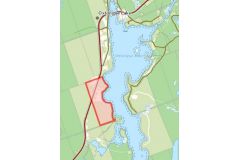Dr. Edwin Augustus Lewis
Settler of township lots: Lot 4, Concession 11, McClintock Twp. (Oxtongue Lake)
Location: Map point is the approximate location in Oxtongue Lake village.
Land Acquisition: 1902 Patent from The Crown for 26 acres in the South part. Ontario Land Parcel Register - McClintock (Image 12). Haliburton Registry Office Copy Book, McClintock, Inst #8, page 16-17
Dates of residency:
Interesting facts:
From MARION BLACKMAN (age 96) interview printed in 1979 the edition of the Vacationer. Source: Facts and Fables of Oxtongue Lake; 2000; p. 107. Read the whole story: Marion Blackman.
The best Mrs. Blackman can remember is that she first began coming 18 miles north-west of Huntsville just prior to the turn of the century, about 1899. Mrs. Blackman and her family were one of the first pioneering tourist families to come to these parts. Her father, Dr. Lewis first came to Dwight in the 1890's (and fished in the Oxtongue Lake are with James Asbury as a guide, mentioned in J. Asbury's daily diary of 101 or 1902). Dr. Lewis and his family first stayed with families in the area and in 1902 purchased the present property. He had an old log cabin moved across the ice to its present spot.
From LEWIS CAMP - BLACKMAN COTTAGE by Ted Blackman. Facts and Fables of Oxtongue Lake; 2000; p. 105. Read the whole story: Lewis Camp - Blackman Cottage
Lewis Camp, a red roofed log cabin located in a west bank clearing, has been an Oxtongue Lake landmark for almost 120 years. Dr. Edwin A. Lewis, a New York City surgeon, was a frequent visitor to the Dwight area in the 1890's. He bought 26 acres on Oxtongue Lake from the Crown in 1902 for $1.00 per acre. In 1904, Dr. Lewis purchased the hand-hewn, two room log cabin which had been built on the east side of Oxtongue Lake by Mr. McCann and his two sons in the late 1800s.
During the following winter, the cabin was disassembled, skidded across the lake by mules and horses, and reassembled in its present location. For many years, the family lore had it that the four bedrooms over the log cabin were added in the 1920s. The truth surfaced recently when photos from about 1906 turned up. They clearly showed the log cabin and its framed second story were then as they are today. The photos also show that the clearing around today's Lewis Camp is much smaller than it was at the turn of the century. A two story, four room addition to the original cabin dates from the 1930s.
To the delight of the present day family and friends who have loved and enjoyed Lewis Camp for many years, Dr. Lewis started a guest book, "The Shack", in 1906. The signatures and comments of the many, many guests of "The Camp" over the past 100 years are a great treat to read.
In addition, the memories and stories recounted by early visitors add charm and pleasure to all who made the trek to Lewis Camp. Marion Blackman, a yearly visitor until she was 96, often told her grandchildren about the challenge of getting to Lewis Camp in those early days. From Huntsville, one took a boat through Pen Lake to the Portage Railway, then took the tiny train to Lake of Bays, where you loaded onto another boat to Dwight. From there, you, your food, and everything else you might need for the duration of your stay at "The Camp" were loaded onto a cart which was drawn along a track to the Oxtongue River and then along the river to the Lake.
Coal oil lanterns, a big wooden icebox cooled by real ice, a hand pump in the front yard which pulled lake water to a tank outside the kitchen and delicious meals cooked on a wood stove by Pearl Parris were all part of summer life at Lewis Camp prior to the installation of hydro in the mid 1950s. Key to happy times enjoyed by Mrs. Blackman and so fondly remembered by her grandsons, were Pearl and Tom Parris.
Preceding landowner: The Crown
Succeeding landowner: From 1920-1980, the property was jointly owned by Dr. Lewis' children, Marion Lewis Blackman and Edwin Tuttle Lewis and their families. In 1985, the property was divided. Mrs Blackman's son Edwin T. (Ned) Blackman retained the cabin and 16 acres; ownership of the remaining undeveloped acreage remains in the family of Edwin T. Lewis. In 1993, following the death of Ned Blackman, Lewis Camp (now well known as Blackman's cottage) was passed on to Ned's son, Ted Blackman.
Link to Settlers of Algonquin Highlands family tree
Photo: Dr. Edwin Augustus Lewis on porch of Lewis camp sometime between 1915 - 1920. Source: Facts and Fables of Oxtongue Lake; 2000; p. 105.